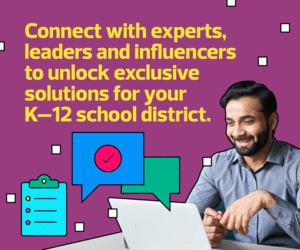Take Advantage of Online Options for Teaching and Learning
One technology solution school districts should consider is having a hybrid or remote learning plan. This would allow students to shift between online and in-person instruction on a rotating schedule.
Remote learning would benefit schools that are having trouble finding substitute teachers to instruct and monitor students when regular teachers are absent. When teachers quarantine as a result of a COVID-19 exposure, their students must be moved to different classrooms for the amount of time that their teacher is out.
With a remote learning plan in place, students and their families can opt for learning from home rather than moving to a new, likely overcrowded, classroom. Some secondary school students may be able to complete their schoolwork on their own time, though this asynchronous approach would not likely benefit younger students.
Synchronous remote and hybrid learning are most efficient when schools dedicate a separate teacher to online students. But with staff shortages, many instructors teach online and in-person students concurrently — an approach that can make it difficult for the teacher to focus on both groups of students. Classroom management tools, such as GoGuardian and Pear Deck, and learning management systems allow teachers to split their attention more efficiently. Such tech tools cannot replace instructor-led learning, but they can help teachers who are struggling to manage tasks in multiple learning environments.
DISCOVER: Interactive ed tech tools help drive student engagement in hybrid and remote classrooms.
Find Ways to Connect on Longer Commutes
Having a remote learning plan may also ease the pressure on bus drivers. If students have the option to stay home to learn, they won’t need to take a bus to school.
Under the current shortage, drivers are being given longer routes in the mornings and afternoons — and sometimes must drive additional routes — to get everyone to and from school. In some districts, because all members of the transportation department must be certified to drive buses, executive directors are being tapped as temporary drivers.
Because longer routes mean students are spending more time on buses, districts have been working to add Wi-Fi to their fleets to allow students to complete homework, study for exams or more easily entertain themselves on the long ride. Wi-Fi–enabled buses parked in strategic locations can also provide connectivity in communities that desperately need it for remote learners.
DIVE DEEPER: Connectivity is key to inclusive technology options for students.
Support Understaffed IT Teams with Services
If districts don’t already have a remote learning plan in place or Wi-Fi on their school buses, implementing these solutions may be a daunting challenge, especially as schools contend with understaffed IT departments.
With all of the device rollouts and new technology initiatives that have taken place over the past year, hiring in the IT department may have struggled to keep pace. As IT administrators deal with more devices and software than ever before, it’s likely that Internet of Things connectivity is also ramping up in their buildings.
IT leaders need visibility into what’s hitting their network so they can properly protect it. With students back in classrooms — each with a personal device and possibly a smartphone and wearable tech trying to connect to the network — there are many more endpoints through which bad actors can attack. IT teams need to be sure all of their users are educated on cybersecurity risks.
RELATED: Security experts join our roundtable to discuss how to protect schools from bad actors.
Additionally, they need to be sure their network bandwidth can support all of the additional devices.
Districts can seek out managed services from technology partners to assist with monitoring their networks for cyberattacks and to augment their IT staff. Managed services can help these understaffed IT departments handle all the new challenges and requests coming their way. CDW•G offers services that provide cybersecurity assessments, network monitoring and even Chromebook security. Despite being easy to set up and use, Chromebooks need regular updates to remain secure on district networks. IT administrators who are new to Google Workspace can benefit from guidance provided by CDW Amplified™ services to understand the Google management tools available to them.
While none of these tech solutions will permanently solve the understaffing that districts face, they can help alleviate some of the burnout for departments that are spread thin. And, for the time being, schools have the federal funds to support these technology life rafts.
This article is part of the “ConnectIT: Bridging the Gap Between Education and Technology” series. Please join the discussion on Twitter by using the #ConnectIT hashtag.
![[title]Connect IT: Bridging the Gap Between Education and Technology](http://www.edtechmagazine.com/k12/sites/default/files/articles/2014/05/connectit.jpg)











